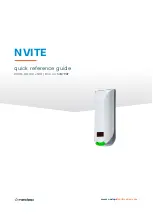
10.4-38
Section 10: Calibrating the Model 9100: Resistance Function
Final Width = 215mm
10.4.7.3
Target Calibration Points
All Resistance function hardware configurations, except the one which produces outputs in the range 00.0000
Ω
to 40.0000
Ω
, have
'UUTi High' and 'UUTi Low' source current modes which can be calibrated separately using appropriate source currents. It is not
advisable to calibrate the 'UUTi Super' source current mode externally, as this requires high source voltages. Because of this, the
'UUTi Super' calibration is done internally from the UUTi High and Low calibrations, and external calibration is not necessary.
Because these source currents are driven into the 9100 front-panel terminals by the calibration equipment, it is essential that the
calibration equipment's range is selected on the basis of the source current which it generates and not solely on the basis of its
resistance measurement range.
To create optimum calibration conditions, the calibration equipment range must be selected so that it:
a. generates a source current which lies within the range required by the 9100 selected hardware configuration
and
b. allows measurement of the 9100 output to be made at as high a percentage of the calibration equipment's range as possible.
For example, suppose your calibration equipment is a standards laboratory DMM which generates a source current of 10
µ
A on its
1M
Ω
range and 1
µ
A on its 10 M
Ω
range. Its 10M
Ω
range should be used to calibrate both the 40.001k
Ω
to 400.000k
Ω
UUTi Low
source current hardware configuration and the 0.40001M
Ω
to 4.00000M
Ω
UUTi High source current hardware configuration, as
both of these require a source current during calibration between 500nA and 2
µ
A (see Table 10.4.7.3 and Table 10.4.7.2
respectively). Although it would appear that the DMM could measure the 40.001k
Ω
to 400.000k
Ω
hardware configuration outputs
more accurately on its 1M
Ω
range, this range cannot be used because its source current is too high.
Table 10.4.7.2 and Table 10.4.7.3 list both the default calibration targets and a set of recommended calibration targets, together
with the source current limits which are applicable during calibration of the 9100.
The default calibration targets are 'ideal' values which give optimum calibration conditions, but are only usable if suitable
calibration equipment is available — i.e. calibration equipment which generates the correct source currents and is traceably
calibrated at these target values. The recommended calibration targets are devised to enable measuring instruments with
decade ranges (for example, DMMs) to be used as the calibration equipment, while employing high-accuracy points on their
ranges.
10.4.7.4
Calibration Equipment Requirements
The procedure is based on the use of a traceably-characterized, long scale-length Standards DMM, using short leads to deliver the
9100 output to the DMM input using a 4-wire connection. For example, a
Fluke
Model 1281 Digital Multimeter.
















































